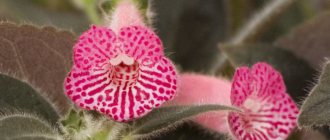Cattleya appeared at home in the middle of the 18th century. The first plant brought to Europe bloomed in a greenhouse in the English town of Barnet in 1818 thanks to the efforts of W. Cattleya, a great connoisseur of tropical flora. Subsequently, D. Lindley, who first described the genus, which today consists of more than 180 species, named it in honor of a gardener and florist from a London suburb.
Graceful representatives of the Orchid family grow naturally in various climatic conditions of Central and South America - in the humid Amazonian jungle on tree trunks in the shade of their crowns, on dry mountain slopes under the influence of direct sunlight.
General characteristics of all types of cattleyas
The inflorescence is apical with one bud or racemose, emerging from the leaf axil, covered with leaf blades growing at the base. The stem is sympodial, underdeveloped succulent. A young plant has several growth points. Over time, only the main shoot remains, the rest die off.
One or two narrowed, oblong leaves are formed in the pseudobulb. The plates are dense, fleshy or leathery, and do not bend during growth. Cattleya happens:
- unifoliate with fleshy, spindle-shaped bulbs with one leaf;
- bifolia with elongated, cylindrical bulbs with two or more leaves.
All false bulbs are connected by a root system. It is a creeping aerial flower, suitable for growing in the mountains or on trees. It can be located above the ground or deep into the soil.
Flowering lasts up to four weeks, the duration depends on the type of orchid. There are varieties that bloom flowers even in spring and winter.
A bud with three petals and the same number of sepals. There is a so-called “lip”. This is the middle petal in the form of a funnel or tube with a shade brighter than the rest, with a fringed edge.
The corolla circumference ranges from a few mm to 30 cm (depending on the Cattleya variety). The color can be pinkish, lilac, crimson, snow-white. As a rule, an orchid has at least four pseudobulbs, from which buds bloom in turn. Cattleya flowers have a pleasant aroma. Cut buds do not wither for a long time even without water.
Is it a poisonous plant or not?
Orchids are one of the most popular plants in cooking, folk medicine and cosmetology. There are only a few varieties of orchids that are not beneficial and can even cause harm. These include exclusively tropical varieties:
- Wanda.
- Cymbidium.
- Sarcochymus.
The Cattleya orchid is considered a delicate and fragile beauty that will decorate a home or garden. It is completely harmless and will delight you with a pleasant aroma and bright colors.
Main types
Cattleya has about 180 species. The most common of them:
| Name | Description |
| Hybrid | The name refers to a large number of hybrid forms obtained by crossing different species and their varieties:
|
| Lubby | The spindle-shaped false bulbs are single-leaved, covered with gray-green scales. The leathery leaves are oblong, obtuse, with a notch at the end. Pinkish or lilac flowers 12-14 cm. Petals are narrow, ovoid with wavy edges, three times wider than the sepals. She is the founder of the clan. |
| Orange-red | The spindle-shaped stems are thin at the base, gradually thicken towards the apex, and are wrapped in a filmy shell. The two ovate or elliptical leaves are tough and fleshy. The inflorescence is located on a shortened peduncle and has from two to ten fiery orange buds. Breeders use the species to produce varieties with yellow or red colors. |
| Forbes | Thin cylindrical or spindle-shaped stems are bifoliate, grow up to 30 cm. The leaf blades are oblong and obtuse. The straight, shortened peduncle holds from two to six buds. The buds are a pale olive yellow or light chestnut shade with slightly darker veining. |
Varieties
There are a large number of representatives of the cattleya orchid. Each hybrid differs in size, shade, flowering duration, etc. The most common types should be considered.
Cattleya bicolor
One of the first representatives of this species, originally from Brazil. Natural environment - rocks, altitude from 400 to 1200 meters above sea level. In savannas it lives in well-ventilated places, protected from sunlight. The growth of such a crop can reach more than half a meter, and the diameter of the flower is 8-10 cm. The larger the size of the orchid, the greater the number of inflorescences it can have.
Blooms in autumn and winter. Cattleya can take on shades of brown, green or orange, with a purple lip and lighter edges.
Cattleya forbesii
This type of orchid was discovered more than two hundred years ago, one of the few white cattleyas. The height of the plant is no more than 20 centimeters, but despite this, the flowers are quite large and can reach 10 cm in diameter. Color: olive green, yellowish green with brown, the “lip” is white with a pinkish tint. Flowering season is summer and autumn.
Cattleya aclandiae
Homeland - Brazil. The species is adapted to living in trees at an altitude of up to 400 meters. A distinctive feature is green leaves with red “freckles”. The culture belongs to small orchids, the height reaches 7-12 cm. In the photo, the color of the Cattleya flower has a pink-lilac tint. Radius – no more than 5 cm.
Cattleya labiata (lipped)
Cattleya orchid lives on the bark of trees. Pseudobulbs have a spindle-shaped shape, the size does not exceed 25 cm. Color: pink, lilac with a “lip” of a similar shade, which has a pink fringe. The radius of flowers can reach 6-9 cm.
Blooms during the summer for a month.
Cattleya mossiae (Easter)
Originally from Venezuela. Flowering in the spring during the Easter holidays. The color of the flowers can range from soft pink to purple, and occasionally white. “Lip” is yellow and purple, with light fringe along the edges. The flower size reaches 18 centimeters.
The most popular forms obtained by sectioning are:
- Brassocattleya Binosa
- Laeliocattleya
- Sophrolaeliocattleya
Usually, they are united under a single name - Cattleya hybrida .
Cattleya growing conditions
In order for Cattleya to intensively develop and bloom, it needs to create the following conditions in the apartment:
| Parameter | Recommendations |
| Location | Any window sills, except the northern ones. In summer, the flower can be placed on the balcony or veranda. |
| Lighting | Bright, daylight should last at least 12 hours. There is no need to protect from the sun in the morning and evening. For illumination, special phytolamps are used; ordinary leaves turn purple. Do not change the light level suddenly. There are species that tolerate shade well (for example, hybrids, combined under the name Patinara). |
| Temperature | During the growing season - +22...+30 ºС. A difference of about +7 ºС is required. To do this, you can open windows and vents, but avoid drafts. During winter dormancy, the temperature drops to +12…+15 ºС. Markings on the thermometer below +5 ºС or above +40 ºС will lead to the death of the flower. |
| Air humidity | The recommended figure is 60-80%. In hot weather, place a container with cold water next to the plant. Spraying the air around the orchid is done in the warm season. Getting water on false bulbs, flowers and pedicels is undesirable. |
Detailed description
If you have a vague idea of what the most beautiful orchids look like, a photo of Cattleya will demonstrate a true miracle. The perennial belongs to the category of beautifully flowering ones. All varieties of this genus are conventionally divided into several types: single- and double-leaved. Professional flower growers recommend growing specimens with a pair of plates in the house. They are less demanding in care. Flower shops sell mainly hybrids distributed for the spring and autumn growing seasons.
One of the most beautiful types of orchids has different bud sizes - from incredibly small to the largest in the family. The color palette is replete with a huge variety of shades - from snow-white to dark purple. The lip always differs from the sepals in shape and stands out brightly against their background in color. Most subspecies have an incredibly strong aroma that lasts all day.
In the central part, the plant has a thickening called a pseudobulb or small false bulb - up to 15 cm. The average length of epiphyte leaves reaches 30 cm.
Features of planting and transplanting cattleya
In its natural environment, the orchid grows on trees, so bark (preferably coniferous) and sphagnum moss are used as a substrate for planting. The first component is soaked for several days for better moisture retention. All ingredients are crushed, polystyrene foam and perlite are added to the mixture. You can also purchase ready-made soil for orchids in a specialty store.
Cattleya is difficult to tolerate landing and transshipment, so it can only be disturbed in extreme cases. When it becomes crowded in the pot, the root system will begin to rot or the plant will need to be revived.
If transplantation is still necessary, it is better to do it in the spring, when shoots form on the bulbs. During this period, the shoots are small, the risk of damaging them is minimal.
Planting in various containers
Mini varieties of hybrid cattleyas, no more than 10 cm in size, develop well in glass gardens - florariums. Planting is done as follows:
- A florarium is prepared: an aquarium, a jar, a vase (any glass container) is used.
- A layer of stones is laid out on the bottom.
- Crushed bark is poured (2 cm pieces).
- A thin layer of damp sphagnum moss is applied.
- An orchid is placed on top and secured with thin sticks.
- The composition is complemented by other exotic plants suitable for florariums (fittonia and others).
- Decorated with decorative elements.
If planting is done in a pot, then when choosing it you need to pay attention to ventilation. The plant loves air; if there is not enough air, it will die. Ceramic and plastic pots are suitable for cattleya.
The advantage of the first material is that it is natural. Ceramics protects the root system from sudden temperature changes. However, the service life of such a pot is short: after three to four years it will begin to collapse under the influence of water due to the growth of roots. Plastic flowerpots are characterized by their low cost and a wide range of shades and shapes. In addition, such a pot will last much longer than a ceramic one.
Planting is done as follows:
- A drainage layer of gravel or expanded clay is laid on the bottom with a layer of 2 cm.
- A layer of bark and coarse sphagnum moss is poured.
- A flower is placed on top, a layer of substrate with smaller pieces of the constituent components is laid out.
- The pot is placed on a tray of water.
History of the genus Cattleya
The flower is native to South and Central America , where it was first discovered by Europeans in the early 19th century. This genus was named after W. Cattley, who was the first owner of a collection of orchids in England. Cattleya has spread widely throughout the world.
These flowers can be seen growing both on the branches of trees in the humid jungle and on the slopes of mountain systems where the temperature drops below zero. This plant quickly gained popularity due to its unusual flowering and leaf shapes that others do not have.
Over two centuries, the orchid has not only not lost its relevance, but is still in great demand as home decor. Since Cattleya is considered an expensive and sophisticated accessory in America and Europe , it is also used to decorate evening dresses.
Flowering conditions
Cattleya blooms when it reaches adulthood. The size of the false bulb in a mature specimen differs depending on the variety, from 8 to 20 cm. If the pseudobulbs have living roots, at least one bulb with a sheath, then the orchid will bloom.
The necessary conditions:
- Flowering cannot be achieved on a north-facing windowsill. Cattleya needs sun. It is recommended to expose the plant to ultraviolet rays in the morning and evening. This should not be done during the sun, as it can cause burns to the foliage.
- The flower must be watered regularly. In summer, the soil is moistened twice or thrice a week, and placed under a warm shower once a month. Without this, the plant will not grow well, resulting in no flowering. However, excess moisture may cause Cattleya to die. Therefore, you need to ensure that the substrate has time to dry out between waterings.
- During active growth, the flower needs feeding. Every month, fertilizer for orchids containing phosphorus and potassium in a minimum concentration is added to the water for irrigation. After the buds form, feeding stops.
- The daily difference between day and night temperatures is at least +5 ºС.
Reproduction methods
Cattleya is propagated by dividing the bush and by children. This is done extremely rarely with seed, since seedlings are difficult to grow and the wait for flowering is long.
An adult orchid bush is divided and placed in different pots. This happens as follows:
- The plant is watered abundantly and left for three to four hours. When the soil is completely wet, the orchid is carefully removed.
- The rhizome is washed well with warm water, and the remaining soil is removed from the shoots.
- The bush is divided into parts using sterile instruments. Each division has from 3 bulbs and living roots. The cut areas are treated with crushed charcoal.
- New bushes are planted in separate pots.
Cattleyas are characterized by the formation of children. When they are not there, it is recommended to use cytokinin paste to stimulate growth. Reproduction occurs like this:
- The daughter shoot is carefully cut from the mother bush. The baby is taken to be quite developed, has living roots and several leaves.
- The sprout is soaked in Kornevin for several hours.
- The shoots are planted in a pot with bark and moss.
- The recommended temperature is maintained in the room (+22…+30 ºС), diffused light is created, and the soil is moistened.
Cattleya orchid plant propagation
How does it reproduce?
The plant propagates by dividing the bush if there are 8-10 bulbs.
To properly propagate a plant, you need to know the sequence of the procedure.:
- First you need to prepare new suitable pots. Fill them with substrate and place them in a container with warm water.
- The roots of the plant must be cleaned.
- Prepare the tool and carefully divide the bush.
- Place the resulting roots in different, pre-prepared pots.
Mistakes in caring for Cattleya and their elimination
If there are errors in maintenance, the plant begins to hurt and may even die. Therefore, you need to know what the pathological condition of the orchid is associated with in order to eliminate the shortcomings in a timely manner.
| Symptoms | Error |
| The peduncle dries out without producing buds. | Lack of light, moisture or fertilizer. |
| Foliage and bulbs turn yellow. | A burn has been caused. |
| The foliage changes color to dark green, the blades become softer and droop. | Lack of lighting. |
| The tips and edges of the leaves dry out and turn brown. | The room temperature is too high. |
| Peduncles have stopped developing, only new shoots are formed. | The flower is too young (it has three or fewer pseudobulbs) or the orchid is not watered correctly. |
| The bulbs at the base turn black, it seems that they are wet. | Excess moisture. The situation is aggravated at low temperatures and drafts. |
Diseases and pests
Cattleya is susceptible to the following ailments:
| Diseases/pests | Symptoms | Causes | Elimination |
| Mosaic | Leaf plates and flowers lose their shape, variegation occurs. | A fungus that begins synthesis in soil that is too wet. | Elimination along with the pot. |
| Chlorosis | Yellowish stains on the leaves. | Iron deficiency. | Replanting into new soil, spraying the leaves with fertilizers. Watering only with soft water, because... Due to the hardness, salts are formed in the substrate. This interferes with the absorption of iron. |
| Root rot | Leaves and shoots turn black. Mold appears at the base. | Excessive watering. | Destruction or resuscitation. |
| Spider mite | White plaques and a thin cobweb are observed on the plates. The greenery fades, first becomes grayish, then brown. | Insufficient air humidity. | Treatment with Fitoverm, Actofit or Vermitek. |
| Shield aphid | Brown plaques appear on the plates and pseudobulbs, and the leaves become dull. | Dry air. | Removing plaques manually, treating with soapy water. |
Reanimation
Errors in home care, various ailments and insect damage lead to the death of the rhizome. The plant needs resuscitation. It is done like this:
- The flower is soaked in water for two hours daily.
- After the roots appear, manipulations stop.
- When the first three shoots grow to 6 cm, the plant is planted in a narrow pot.
Resuscitation may last several weeks or even a year. It is recommended to carry out the manipulation in the warm season or in greenhouse conditions at a temperature of +20…+25 ºС.
The annual development cycle of an orchid
- Growing season or period of new growth
Every year in the spring, and in many hybrids several times a year, young shoots appear at the base of the pseudobulbs, which emerge from certain buds.
Each pseudobulb has from 1 to 3 such buds. Most often they are hidden under a leaf wrapper and are not visible until they swell.
You should not remove the dried wrapper from the pseudobulbs , as it protects the young buds from damage and drying out.
- Maturation of new shoots or formation of new pseudobulbs
The period when the new sprout has developed well enough and itself begins to turn into a new pseudobulb.
- Winter dormant period
The onset of winter rest is due to only one thing - insufficient lighting for growth.
As long as the intensity of sunlight outside the window is sufficient, the orchid will grow new roots, sprouts, flower stalks, etc.
As soon as the weather changes, the metabolism inside the orchid begins to slow down, and a period of rest begins.
- Flowering period
Early spring or dry, sunny autumn can cause new pseudobulbs to ripen earlier, and they will have time to bloom before winter “hibernation” begins.











